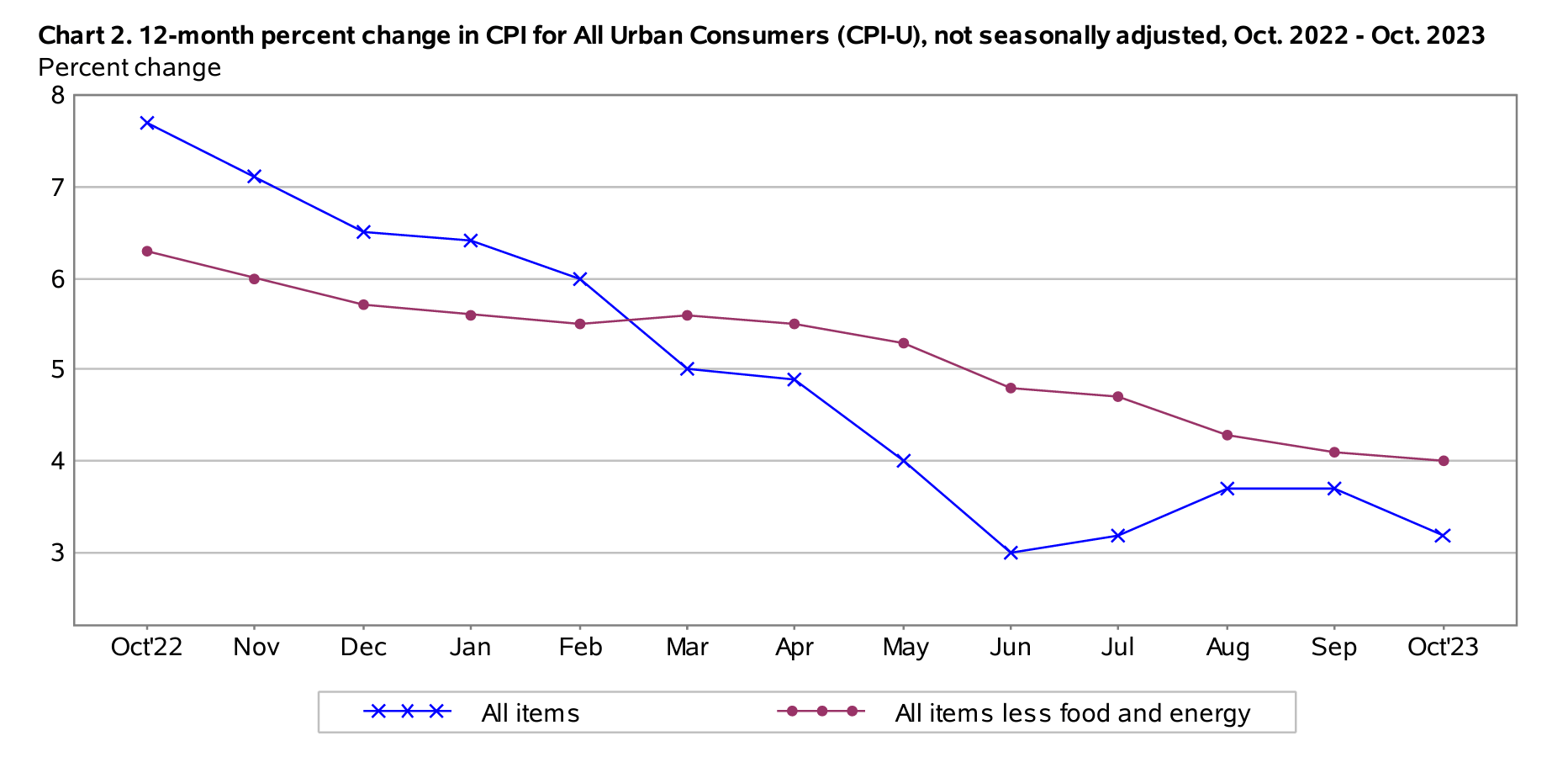The Dow Jones Industrial Average spiked 400 points on Tuesday morning upon release of softer-than-expected inflation data for October.
The October 2023 report of the Consumer Price Index of All Urban Consumers (CPI-U) indicates that inflation was unchanged for the month, following a 0.4% monthly increase in September and a 0.6% increase in August. These data were released at 8:30 am EST on Tuesday morning, November 14, by the Bureau of Labor Statistics. Before seasonal adjustment, the year-over-year (Y-o-Y) inflation rate in the all-items index grew by 3.2%, marking a major deceleration from September’s CPI report.
October’s CPI report came in .1 point cooler than anticipated in every category (i.e., monthly unadjusted, year-over-year, core) according to an aggregated forecast report that cited a 3.3% expected year-over-year increase.
Financial markets opened on Thursday morning at a loss following September’s inflation news. The Dow Jones Industrial Average is down 90.55 points as of 11:30 a.m. on Wednesday, and the S&P 500 is down by 4.19 points.
The main driver of this month’s inflation deceleration is the reduction of energy prices in October, which dropped 2.5 percent. Price reductions in the energy sector offset price increases in the food and agriculture sectors. As a whole, the October 2023 CPI report was a pleasant surprise for most investors and market watchers, providing material support in favor of the Fed’s hawkish interest rate campaign. With this month’s positive inflation date, it is all but certain that future rate hikes will not take place in the near term.
Source: Bureau of Labor Statistics
October’s monthly CPI figure marks a sharp deceleration from September’s (0.4%) and August’s (0.6%) and remains the lowest CPI reading on a monthly basis in 2023. As depicted in the table above, the September 2023 CPI figure was largely driven by decreases in energy costs and energy commodities, including fuel oil.
Food Prices
The food index rose by 0.3 percent in October, a marginal increase over September, August, and July, which all saw increases of 0.2 percent. Notably, four of the six food sub-indices rose in October, including the index for meats, poultry, and fish, which rose by 0.7 percent, as well as pork which rose by 1.3 percent. Concurrently, the food at home index rose by 0.3 percent overall.
Energy Prices
Following a 1.5 percent increase in September and an even larger 5.6 percent hike in August, the energy index dropped 2.5 percent in October. The index for electricity rose by only 0.3 percent after a much more significant 1.3 percent increase in September. On the year, the fuel oil index fell by a precipitous 21.4 percent, marking the largest single-month decline in this key index in 2023.
On an annual basis, the energy index fell by 4.5 percent with mixed components, with the electricity index rising by 2.4 percent on a year-over-year basis.
Core October 2023 CPI
Regarding the core CPI data for October 2023 (i.e., inflation less food and energy), the index rose 0.2 percent month-over-month, beating September’s increase (0.3%) and maintaining July and June’s core CPI acceleration of 0.2 percent. Below is an itemized breakdown of the main price fluctuations seen in October’s core CPI reading:
- Rent index: +0.5%
- Lodging away from home: (-2.5%)
- Motor vehicle insurance: +1.9%
- Medical care index: +0.3%
- Used cars and trucks: (-0.8%)
- Recreation +3.2%
- Personal care items: +6.0%
Source: Bureau of Labor Statistics
Seasonally Unadjusted CPI Data for October 2023
Before seasonal adjustments, the CPI-U for October 2023 increased (+3.2%) year-over-year, rising to an index level of 307.671. Since these figures are unadjusted, they include regular seasonal price fluctuations that generally occur by the same margins every year.
Source: Bureau of Labor Statistics
Protect Your Wealth This Holiday Season
October’s inflation reading came as a relief to countless investors who have been waiting for a marked slowdown in consumer price increases. Yet there’s no telling when or if inflation will begin to reaccelerate. Over the past 18 months, American families have seen their purchasing power diminish month after month, and the average American worker now has less of their paycheck to devote to monthly expenses. All the while, personal debts have risen fast—in fact, America’s total credit card debt exceeds $1 trillion and student loan repayments are once again mandatory after an over 3-year freeze on interest accumulation.
Fortunately, you have the power to counteract the negative effects of inflation and other worrisome macroeconomic indicators. Consider consulting with a financial expert about diversifying your investment portfolio with alternative assets. Hard investments in gold and silver have the potential to shield your savings from the diminishing value of the U.S. dollar and help you retain your wealth during inflationary environments.
Historical events in 2008 and 2020 have shown that assets like gold and silver have outperformed conventional securities during market turbulence. For many, gold serves as a safeguard against inflation, offering a dependable store of value when traditional assets falter.
Interested in diversifying with gold or silver? Get started by opening an account with one of the top-rated gold IRA service providers. In the meantime, our complimentary CPI inflation calculator tool can help you monitor how inflation is impacting your household over the upcoming holiday season and beyond.




